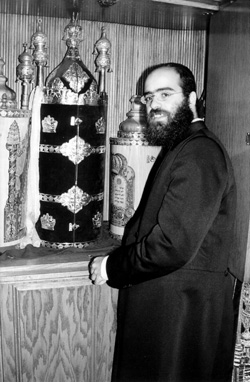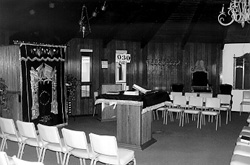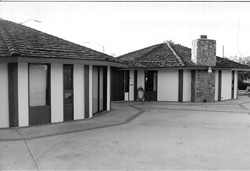By
Donald H. Harrison
Chula Vista, CA (special) -- Rabbi Daniel Menachem Mendel Srugo at 26
is the spiritual leader of the only Sephardic congregation in San Diego
County: the Beth Eliyahu Torah Center located in the Bonita section of
Chula Vista.
If his middle names -- Menachem Mendel -- sound familiar, it is because
he was named after
Rabbi Menachem Mendel Schneerson, the late Lubavitcher rebbe. This
was not because he
was born into a family affiliated with the Lubavitcher movement --
such affiliation didn't
occur until he was nearly a teenager. Rather it was because "my grandmother
could not
have any children for about four years. She asked for a baracha
(blessing)
from all the
tzaddikim (righteous people) and the famous rabbis in Israel
and all over the world, but they
still couldn't have any children. Then they went to the Lubavitcher
rebbe and he gave her a
blessing and right away she became pregnant."
The grandmother bore the daughter who became Srugo's mother, and "my
mother felt she
should have some appreciation. So she called me 'Menachem Mendel.'
Since my father
wanted to call me 'Daniel' they put it all together. But my father
ended up winning: they
call me 'Daniel,' not 'Menachem Mendel.'"
 |
But perhaps it was the mother who won after all. After
Srugo's father moved the family from Argentina to Mexico City to establish
a kollel (a center where rabbis study together and teach), its success
in expanding from about four members to 30 was remarked upon by the Chabad
movement. "My father was asked by the head rabbi of Chabad in Argentina
to come back and open a yeshiva for Chabad," Srugo said.
"My father asked a baracha from the rebbe, who told him it was really
a good thing to do, a good and important cause. So he went back to Argentina
and started a yeshiva with five boys who were between the ages of 12 and
14. I was 12. Today the yeshiva has between 50 and 70 people."
A teacher of Torah, Srugo's father, Rabbi Marco Srugo, had been friendly
to Chabad but not a member of it. "But then as you can |
| Rabbi
Daniel Srugo |
influence people, so too can you be influenced, and my father was influenced
for good things by Chabad," Srugo said. "First the children became members
of Chabad, and then my father."
People normally may associate the Lubavitcher chassidim with Ashkenazim
(Jews from Eastern and Central Europe) rather than Sephardim (Jews tracing
their roots to Spain) because the town of Lubavitch, where the movement
had its origins, is in Russia. But Srugo, who was born in Buenos Aires,
Argentina, to Syrian Jewish parents says for a Sephardic boy to become
a Chabad rabbi is not so uncommon. In Israel, he asserted, the majority
of the people affiliated with Chabad are Sephardic, not Ashkenazic in origin.
Through the Chabad movement, Srugo became conversant with the rites
of both the Sephardim and the Ashkenazim. From his father's yeshiva in
Buenos Aires, he went to study for 2 1/2 years in Kiryat Gat, Israel, then
went to another yeshiva in Morristown, N.J.,about a two-hour drive from
Lubavitcher headquarters at 770 Eastern Parkway in the Crown Heights section
of Brooklyn, N.Y.
"It was a very important time in our lives because we (students at the
yeshiva) used to go
every week there to be by the Lubavitcher rebbe for Shabbat," Srugo
said.
From the Morristown, N.J., yeshiva he transferred to another yeshiva
in Montreal,
Canada,
from which he was sent as a shaliach (emissary) to Caracas,
Venezuela, where he served as
a rabbinical assistant. Then he was dispatched to Germany
to serve as a supervisor of kashrut for factories manufacturing
chocolate. He returned to New York after that assignment, then in 1997
he received an important message from a former classmate in Argentina --
Rabbi Mendel Polichenco, who just had become the new Chabad rabbi at the
Centro Social Israelita (Jewish Social Center) in Tijuana,
Mexico.
Polichenco told him he needed some help operating a youth camp in Tijuana,
so Srugo came
to help his old friend. "And I heard that the community of Bonita needed
a rabbi; that their
rabbi (Shlomo El-Harrar) was leaving. One day I was in the neighborhood,
so I came for the
Shacharit (morning prayers) service with them, and they asked me to
come back."
After receiving his smicha (ordination), Srugo began serving the small
congregation as its
rabbi in March of 1998. In a way it was ironic that he came to the
congregation via the
Centro Social Israelita because Beth Eliyahu Torah Center, itself,
could trace its beginnings
to the same congregation.
* * *
Mario Adato was one of the founders of the congregation in Bonita, which
was initially
called Congregation Beth Torah. It was renamed as Beth Eliyahu Torah
Center about four
years ago.
"Most of the members belonged to the synagogue in Tijuana," recalled
Adato, who is in the
leather business, "but the thing was they all wanted to have Sephardic
services and
Orthodox, of course." At the time, the synagogue at the Centro was
led by Cantor Max
Furmansky, who was both Ashkenazic and a member of the Conservative
movement.
Before the new congregation was organized formally, a group assembled
in 1978 for the
High Holy Days in Chula Vista, with Cantor Haim Mizrahi persuaded to
come in from
Mexico City to lead the services.
Afterwards, "we started to think about how we were going to bring him
permanently," Adato
said. "We started working on that and several months after that, probably
the beginning of
1979, we finally brought him to San Diego and started Beth Torah."
 |
About 15 families were involved in the start-up of the
new congregation: including those of Mauricio Amos, Morris Benguiat, Abraham
Hanono, Isidoro Lombrosa, Solomon Mizrachi, and Jose Nakash, as well as
Adato himself and his brother, Mauricio Adato. The sisterhood proved to
be an important part of the congregation, and still is, with Licha
Mizrachi, wife of Solomon Mizrachi, serving as the sisterhood's first
president.
Although the congregation's members came to the Mexico-U.S. border area
from a variety of Latin |
| Beth Eliyahu
Torah Center sanctuary |
American countries, their families traced their roots to countries throughout
the Sephardic world, including Israel,
Syria,
and, in Adato's case, Turkey.
Adato noted that Sephardic and Ashkenazic congregations have many of
the same prayers and Torah readings each week, so it is not in content
but in style that the prayer services of the Sephardim and the Ashkenazim
differ. Normally, "we read exactly the same thing but in a different way,"
he said.
On occasion, he said, Sephardim will include in their services "certain
prayers that they don't do and vice versa" but in the main, it is the chanting
that is different. "Remember we Jews went to different countries and we
started singing the way the people of the countries we went to used to
sing. Our cantor conducts the service the Turkish way. And if you have
someone who is from Morocco,
they are going to do it the Moroccan way."
Cantor Mizrahi served the small congregation for about ten years, becoming
known also
throughout San Diego County as a mohel, before moving to a position
in the Los Angeles area. The congregation was then and still is now too
small to afford both a full-time rabbi and a full-time cantor. It chose
to seek a rabbi, rather than a cantor, as Mizrahi's replacement. The first
man they hired came from Argentina, but Rabbi Ben Shimon returned there
in less than a year, for a better financial opportunity. Next came Rabbi
Shlomo El-Harrar, an Israeli of Moroccan parentage, who served the congregation
for five years before moving on to Miami about two years go.
During El Harrar's tenure, founder Solomon Mizrachi offered the congregation
a deal it could not refuse. It could have for its home a group of buildings
Mizrachi owned at the intersection of Bonita and Central Avenues, provided
that the congregation agree to remain both Sephardic and Orthodox and that
it rename itself as Beth Eliyahu Torah Center in memory of Mizrachi's father,
Elias Mizrachi. Also the congregation would have to make a payment of $1
a year.
 |
"But in truth he didn't really want the $1 a year," laughed
Adato, a former president of the congregation. "His family pays far beyond
that in their dues, and some of them don't even live here. They live in
Panama."
Solomon Mizrachi later died, but his family remains quite active in
the congregation' affairs. His brother Mo and sister-in-law Grace Mizrachi
recently moved to the community from Panama
City to be closer to their sons, Michael and Rafael. The
latter is the congregation's current president. |
| Exterior of Beth
Eliyahu Torah Center |
Adato recalls that "Rafael and I went to see Rabbi (Yonah) Fradkin (of
Chabad of San
Diego) and asked him if he could send us a young rabbi, a student rabbi,
from the yeshiva of
Chabad but we wanted a Sephardic rabbi." As it turned out, Srugo already
was preparing to
come to help Polichenco in Tijuana.
"Rabbi Srugo is very young, but he has a lot of good things going for
him," Adato said. "We
wanted a very young rabbi so he would be attractive to children and
to very young people.
Because we really think the future of our congregation is young people.
If they get used to
coming to the synagogue and getting involved with Judaism, with a young
rabbi there are
more chances that they an continue coming."
Adato estimated the congregation now has between 70 and 90 families,
"but thank God
certain families have two or three (adult) children and when they come
it is not hard to have
a minyan.
"When we get a little more strength what we would like to do is start
inviting guest speakers
to give some classes or lectures to the congregation about Sephardic
culture and Judaism in
general, but it will take a little more strength."
* * *
HERITAGE readers may be familiar with Grace Mizrachi from the series
that
we did on the
Jewish community of Panama last March. Now ensconced in a home in Bonita,
the
outspoken mother of Beth Eliyahu Torah Center's president is on a campaign
to forge
greater bonds of unity not only among Sephardic Jews but among Jews
generally.
In some places in the Jewish world, Mizrachi says, the assimilation
rates seem as high as 80
percent, which she compares to a "second Holocaust" insofar as its
possible effect on the
Jewish population. Inspired by the work of Dr. Jose Nissim in Los Angeles,
who has built a
Sephardic Center there as well as another Sephardic Center in Jerusalem,
the energetic
Mizrachi advocates creating a Sephardic Center in Bonita that would
serve
Spanish-speaking Jews from both sides of the U.S.-Mexico
border in particular and all Jews,
including English-speaking ones, in general.
Although they are not related by blood, she and Nissim have a common
aunt. Having been
a financial supporter of Nissim's centers for over 20 years, she enthused
that "his name
'Nissim' means miracles and miracles took place." However, she said,
"I told him that I
have problems with the name 'Sephardic Center' because my daughters-in
law are
Ashkenazic. So we should say that it is the 'Sephardic Center in Jerusalem
for all Jews.'
He said 'okay, write me a letter, and I did, and any time I get a letterhead
without the 'for all
Jews,' I remind him and right away he will rectify it."
Nissim, she said, is a miracle worker. "They have 200 people coming
every Monday night
over there in Los Angeles" to attend lectures and other cultural events.
Recently, the Los
Angeles center staged a Shabbaton for young adults at the Rosarito
Beach Hotel in Baja
California. It was attended by a couple of youth from Beth Eliyahu
Torah Center, and won
high marks from Rabbis Srugo and Polichenco, according to Mizrachi,
because kashrut and
Shabbat were strictly observed.
* * *
Over a lunch at Sheila's Restaurant in the Clairemont area of San Diego
-- one of only a few
establishments in the San Diego-Tijuana region where one can have a
kosher meat meal -- I
asked Rabbi Srugo his feelings about a Chabad-led congregation working
closely with the
Sephardic Centers (for all Jews) in Los Angeles and Jerusalem
"In the Torah it says that if you have a rope that is made from three
ropes, it will be much
harder to break," he replied. "If you have the Yellow Pages (of the
telephone directory) and
you try rip each of these pages, they are thin. But try to rip the
whole thing together it would
be impossible. As long as we get together, it makes us only stronger.
As long as it is done
the right way, we can work together and bring the communities together."
Like Mizrachi, Srugo does not want the distinctions between Ashkenazim
and Sephardim to
be overstressed. Like her, the rabbi has a good family reason. About
a year ago, he married
the former Esther Applebaum, an Ashkenazic, Orthodox woman of Argentine
background
who grew up in Brooklyn. As this edition of HERITAGE was going to press,
the couple
was expecting a first child.
They were married after Srugo took his post at Beth Eliyahu, and already
she had made an
important difference to the congregation, the rabbi said. "All the
help and support she
gives," he said with enthusiasm. "Sometimes a man cannot communicate
the same thing to
a woman as a woman can. As much as I tried to communicate with girls,
she was able to do
it the right way!"
Instead of making the differences between Ashkenazim and Sephardim a
reason for division,
Srugo said, they should be a reason instead for celebration. Each group
can learn from the
other, he said.
"Some things among the Ashkenazim are more strict and some things for
the Sephardim are
more strict," he said. "For example, on Pesach it seems the Ashkenazim
almost don't eat
anything. Many vegetables they don't eat likes beans and rice, but
the Sephardim will.
Some Ashkenazim in Chabad will not eat matzoh if it gets wet, so they
won't allow matzoh
in anything, not in chocolate, for example. Whereas we will eat matzoh
with everything."
Among some Sephardim, he said, there is a custom of not eating anything
before morning
prayers -- a stricter standard than the one followed by Ashkenazim
in Chabad. "What the
rebbe said is that it is better for a person to eat in order to pray
than to pray in order to eat,"
Srugo said. If someone is irritable, "he is not going to be able to
concentrate, so it is better to
eat something before the prayers."
While on the subject of food, Srugo mentioned that there is a Sephardic
custom associated
with beans known in Hebrew as rubya. Because the name of the Hebrew
prayer She Yirbu,
beseeching God to increase our merit, has a similar resh-bet letter
combination in its name, a
custom is to eat rubya "so that we should have a lot of merit in front
of HaShem."
After telling stories about how customs vary between Sephardim and Ashkenazim,
Srugo
emphasizes this point: "We are all the same. We all came out of Egypt.
We all received the
Torah together. It doesn't make any difference what the customs are.
At the time of the
Talmud, we saw people arguing days and days about a certain law. They
were trying to find
the truth, and so they were still friends. Today, the reason that we
have different customs is
that we should become better, not that we should fight.
"I will give you an example. In our congregation, we have people from
all over -- Turkey,
South America, Israel, Americans. Instead of one saying about the other
'No, I don't like
him because he doesn't have the same customs I have,' we say 'okay,
because we are people
from so many different place, let's teach each other about the nice
customs that we have and
let's try to learn from each other.'"
Such multiculturalism among Sephardim also should be and is extended
to Ashkenazim,
said the rabbi. "It used to be, many years ago, that if you got married
to an Ashkenazi, you
were considered not good anymore; you would have to look for another
place. Today,
thank God, it isn't like that any more. We know, people have come to
realize, that we are
all Jews and we are all part of one big unity."
|

